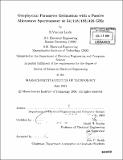Geophysical parameter estimation with a passive microwave spectrometer at 54 / 118 / 183 / 425 GHz
Author(s)
Leslie, Robert Vincent, 1972-
DownloadFull printable version (30.09Mb)
Other Contributors
Massachusetts Institute of Technology. Dept. of Electrical Engineering and Computer Science.
Advisor
David H. Staelin.
Terms of use
Metadata
Show full item recordAbstract
(cont.) model of a convective cell is presented that provides a physical basis for this relationship. The National Polar-orbiting Operational Environmental Satellite System (NPOESS) Aircraft Sounder Testbed-Microwave, or NAST-M, includes passive microwave spectrometers operating near the oxygen lines at 50-57 GHz, 118.75 GHz, and 424.76 GHz, and a spectrometer centered on the water vapor absorption line at 183.31 GHz. All four of the spectrometers' antenna horns are colocated, have 3-dB (full-width at half-max) beamwidths of 7.5⁰, and are directed at a single mirror that scans cross-track beneath the aircraft with a swath up to 100-km wide. The 183.31- and 424.76-GHz systems were developed as part of this thesis. The calibration techniques for two high-altitude airborne platforms are described and validated for two recent deployments. During these two deployments, various precipitation phenomena were imaged by NAST-M's radiometric and video instruments. Retrieval methods were developed and tested for single-pixel rain rate, precipitation cell-top altitude, and cloud-top altitude retrievals of convective cells. The basis of the single-pixel retrievals is a simplified convective-cell hydrometeor-profile model used with a radiative transfer solution that included absorption by atmospheric gases and by hydrometeor absorption and scattering. Two retrieval techniques were used to relate the simulated brightness temperatures to the actual brightness temperatures from the deployments. Case studies are presented from each deployment. In addition, a technique for estimating the cell-wide aggregate rain rate (km² · mm/hr) is presented based on the microwave radiometric signature. The cumulative 3-decibel perturbation areas of convective cells in the four frequency bands are shown to be related to their aggregate rain rates. A simple three-dimensional
Description
Thesis (Sc. D.)--Massachusetts Institute of Technology, Dept. of Electrical Engineering and Computer Science, 2004. Includes bibliographical references (p. 263-271).
Date issued
2004Department
Massachusetts Institute of Technology. Department of Electrical Engineering and Computer SciencePublisher
Massachusetts Institute of Technology
Keywords
Electrical Engineering and Computer Science.